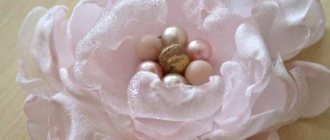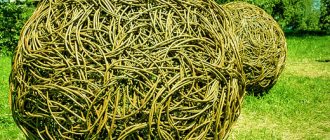Every autumn until late winter we are captivated by the small orange-red shiny pods of the Physalis lantern flower. Wild beauty combined with filigree lightness is a must-have element for atmospheric autumn home decor.
Tiny “lanterns” can be collected not only in your garden or bought in flower shops, but they can be found while walking in the fresh air, in the forest. With their bright, warm tones, they immediately attract attention and add colorful accents to flower arrangements, fall wreaths, tables or windowsills.
The lantern flower is called physalis: it belongs to this large genus of plants.
My Beautiful Home
It is important to distinguish the edible, tasty physalis, which is usually bought in the supermarket, from the decorative physalis, that is, the lantern flower.
Below we'll tell you what the difference is, and below you'll find plenty of decorating ideas with this charming plant that are easy to implement and invite autumn into your home.
Bouquet of physalis for the winter. Recipes from Physalis edible
A wide variety of dishes are prepared from the fruits of physalis; it easily fits into traditional recipes for our cuisine, adding a special piquancy and jelly base to them.
Therefore, there are no special secrets here, only your imagination is required. But there is one important detail in the technology for preparing vegetable physalis - the fruits should be thoroughly “washed” from the sticky oily coating. To do this, pour boiling water over them for 3-5 minutes or blanch for 2-3 minutes. After such hot processing, the vegetable acquires a pleasant taste and can be used to prepare any dishes, as well as eaten fresh. Otherwise, the preparation of vegetable physalis is no different from other vegetables: it is pickled, salted, making an excellent appetizer, even cabbage is fermented with it. Its fruits are stewed, fried and baked with other vegetables; excellent caviar and puree are prepared from it. When boiled, physalis has a sauce-like consistency and a pleasant fresh aroma, so it is perfect for preparing various sauces, improving the taste and structure of other vegetable, including spicy, sauces and ketchup. So, by replacing half the amount of tkemali (unripe plum) in the sauce of the same name, you will get a very fresh and piquant aromatic dish. Physalis also wonderfully complements our vegetable and cereal soups, adds an original note to traditional borscht, and changes the usual taste of pickle and cabbage soup. Try it and you will appreciate how easily and for the better the taste of your usual lunch can change. The fruits of vegetable physalis can also be eaten fresh, added to vegetable salads, and prepared as a “raw” sauce, similar to the famous Mexican Salsa Verdi. By the way, to prepare this hot sauce, they take exactly green, slightly unripe fruits, generously seasoning it with hot pepper. Its sweet varieties are used to make excellent jam, jelly and marmalade. But the fruits of the physalis berry do not require a hot bath; they can be eaten directly from the bush or used to prepare sweet culinary masterpieces: compote, jelly, preserves, jam, puree, marmalade. They make excellent marmalade and marshmallows, amazing jelly sweets and candied fruits. The berries are used in baking pastries and cakes, and as a filling for pies. And if you carefully cut the wrapper and, freeing the berry, dip it in melted chocolate, you will get an original and delicious candy decoration surrounded by golden petals. You can even make liqueur or liqueur from fresh ripe fruits of strawberry physalis.
Care
Physalis seedlings do not require too complicated care.
- Loosening and getting rid of weeds will help the plant actively gain strength.
- Watering is carried out depending on weather conditions. On average, it is recommended to water the plant a couple of times a week; in very dry summers, the number of procedures is increased to 4 times, but it is important to remember that excess moisture can damage the plants.
- Physalis should be fertilized during the flowering period and when fruits form. The best option would be mineral supplements.
How to make a bouquet of physalis.
Here is the physalis in the photo. Of course everyone saw him. It always comes back into fashion from time to time because it is a dried flower. These bright orange lanterns will remain there until spring. But such a simple bouquet, as we see in the photograph, is far from the limit of the decorative value of physalis.
For example, what a wondrous beauty! Bright autumn wreath made of physalis.
The plant is very beneficial for decorative purposes. It is enough to dry the branches you like with lanterns in a vertical position. You can tear off the lanterns and dry them separately. They dry without problems; as soon as they ripen, they are practically dry on their own. The flashlights are thin, but quite strong, and can be stored for a long time, a year or two or more. If you add other suitable decorative materials, such as sisal, to physalis, you can create very interesting compositions. By adding physalis to ready-made bouquets, you get a wonderful opportunity to refresh them and add bright autumn colors.
Dried flowers are often used in scrapbooking, appliques, and the design of topiaries and figurines.
A festive garland of physalis flowers looks impressive. Just remember that you can only use LED bulbs for this purpose, which do not heat up. Dry, paper-thin physalis boxes are very flammable. To make such a garland, you need to cut out the stalk with small scissors and remove the berry from the box. Make the hole as small as possible so that later the resulting caps do not fall off the garland. Place the caps on the lamps of the finished purchased LED garland.
How to make little gnomes from physalis fruits.
- dried physalis flowers,
- wood beads,
- felt or fleece,
- ribbons and some threads that will be hair
- acrylic paints or indelible thin market,
- scissors,
- glue gun or wood glue.
The bead will be the head of the gnome. The physalis lantern itself is the body. We will make a collar and cap from felt.
Cut out a circle from fleece - the future collar. Cut eight petals around the perimeter of the circle.
From a fabric of a different color, cut out a triangle with two sides of 7 cm each - this will be a man’s hat. We roll the triangle into a cone and fasten a ribbon loop inside. Pull the loop itself outward, and secure the knot inside well with glue. We connect the sides of the cone and sew (or glue). Focus on the size of the bead.
Draw a gnome's face on the ball. Use a brush and acrylic paints or markers to define individual facial features. Now glue the yarn hair. Glue the finished cap with a loop for hanging to your hair.
Selecting a location
This unpretentious plant will easily take root in any soil. But a few rules will help Physalis gain strength and please you with a rich harvest.
- It is not advisable to use the area where tomatoes or potatoes used to grow, and the space vacated by cabbage and cucumbers is perfect for physalis.
- Sunlight will help the plant produce many berries and improve their taste.
- The soil for physalis is selected to be light, well-ventilated and permeable.
Bouquet of rowan. Now I definitely bring rowan fruits from the dacha. Incredibly beautiful result
Beauty autumn has already entered her domain. The changeable weather has long been noticeable; it began to drizzle. A lot of yellow, red, burgundy, orange and even purple palettes appeared. If you want to create a cozy mood at home, then why not let the autumn colors into your apartment door? After all, you can easily make autumn compositions from foliage, rowan berries and other fruits. Rowan is an ideal material for autumn creativity, which can warm the soul with its bright colors even in severe frosts. Therefore, today we want to present to you a selection of 21 bright compositions using the gifts of autumn.
Compositions from autumn materials
Multi-layer wreath with dry lavender, greenery, apples and decorative pumpkins
A bouquet without flowers - from pine cones and more. Yes, imagine, this happens, isn’t it, it’s just magic.
Simple compositions from rowan fruits are a decoration not only for the garden, but also for the home.
A candlestick made from natural materials will add a special romantic mood and comfort.
An extraordinary approach to decorating your home and creating an autumn composition. Let's take note.
An amazing riot of colors!
A couple more original ideas for a wreath on the door!
You don't have to be a florist to create compositional masterpieces. The main thing is to show your imagination!
Pumpkin is an ideal fruit for creating autumn bouquets.
If you are not in the mood to make something, but the desire for a drop of autumn to appear at home exists, take a walk along the street and simply collect the gifts of nature. Pick a couple of autumn leaves, a branch of rosehip, rowan, look for sea buckthorn, pick flowers, collect it all in a huge bouquet, put it in a vase and enjoy the autumn still life.
Source
Basic instructions for beginners
Topiaries of even the most complex designs are made according to approximately the same principle. Having mastered the basic manufacturing technology, you can create a wide variety of topiaries, changing only the materials for decoration.
So, to make a mini-tree with your own hands, you will need to create it:
Step 1: Design Planning
Topiary can be different not only in design, but also in service life. Before you start work, think about why you need a “tree of happiness” and where will it live? The purpose and future location of the topiary will determine its style, color scheme and even the materials for its creation.
Bouquet for the winter from physalis. Decorative physalis
Decorative physalis is an unpretentious perennial with an elongated stem completely covered with bright orange “lanterns”.
This plant also has edible relatives: vegetable and dessert varieties. The vegetable variety is canned instead of tomatoes in lean years. And the fruits of strawberry physalis are used for compotes and jams.
Ornamental physalis has many other names - field cherry, Jewish cherry, winter cherry, Chinese lantern. And the eternal romantics of the French dubbed this plant L'amour en cage - “love in a cage.”
And for good reason: if the orange box of physalis falls into water or under heavy rain, it loses its protective layer, and only a weightless openwork “skeleton” remains - a cage in which a small fruit of a rich red color rolls around.
A juicy allegory suggests itself: love, enclosed in a light “silver cage”.
This type of physalis requires the most standard care: watering and periodic removal of weeds. Colorado beetles do not bother him at all, although he belongs to the same family as potatoes, tomatoes and eggplants.
But the main charm of this culture lies in its decorativeness. When dry, the lanterns do not lose their amazing brightness all winter long. A winter bouquet of decorative physalis does not even need additional decoration with other dried flowers.
Or you can cut off shoots with partially ripened bolls, and then you will have green, red and orange lanterns hanging on each branch. If you carefully cut the flashlight with nail scissors and open it, you will get cute little and durable “flowers”.
To make the leaves of the box transparent, you can resort to the so-called skeletonization - a term familiar to every florist.
To do this, lanterns are dipped in a boiling soda solution (two tablespoons of the substance per half liter of water) and cooked over low heat for 30 minutes.
Then each lantern is opened along the venation lines and a small tomato fruit is removed. After this, using light tapping with a soft brush, carefully remove the remaining bright skin, periodically rinsing with water. As a result, you will be left with only a web of tiny veins.
It is also recommended to place the bare flashlights on a sheet of white paper, on which all flaws in the cleaning will be clearly visible, and in the same way remove all remnants of the red film.
Next, all you have to do is dry the handmade products, placing them between several layers of paper and placing them under a press. Such blanks will add zest to any flower arrangement, especially if you make their color more expressive with the help of aerosol paints.
Physalis decorative bouquet. We use Physalis to the fullest extent
Ornamental physalis, often called “Chinese lanterns,” is a very bright and beautiful plant. Its main characteristic feature is the presence of a “flashlight” in which the berry is enclosed. Bright red-orange lanterns are visible from afar. The bush has a decorative appearance, and the branches are often used to make “winter” bouquets.
Features of the plant
The berries of the decorative physalis are not edible. They taste bitter and are literally good for nothing. The plant is a perennial, reaching a height of 60 cm. It belongs to the nightshade family like tomatoes, eggplants and potatoes. The decorative category includes Physalis Common and Physalis Garden.
Edible types of physalis: Peruvian, strawberry, Mexican. They are very heat-loving, and it is recommended to grow them in seedlings. Plants are not decorative; you should plant them only if you need fruits.
How to dry physalis and make a bouquet out of it
When all the lanterns are uniformly red, cut off the branches you like. Tear off the leaves. If you want to have a bouquet with drooping branches, you can dry it directly in a vase. If you want the lanterns to point upward, hang the branches upside down and tie them to a straight stick. This way the branches will straighten and take the position you want. The bouquets are beautiful in both forms. A good addition would be dried tansy, cotton (can be bought at a flower shop), dry branches, ears of corn, haretail, Echinops and other dried flowers.
Physalis is a very decorative plant, products from which look organically in a country interior.
What else can be made from physalis
Also, physalis is used to make decorative wreaths and children's crafts. Lanterns can be torn from branches with cuttings and tied with thread. You will get a natural garland. If you pierce the lanterns with a needle and place them on a thread close to each other, you will get beads. Physalis is very actively used in floristry and decoration.
general information
Physalis grows into a fairly large shrub thanks to its branching stems. The average height ranges from 60 to 120 cm. Moreover, in 1.5 months one such bush easily produces up to 150 small fruits.
Physalis is the largest genus in its Solanaceae family. In nature, it is more common in South and North America, but is already quite common in Asia and Europe. The name means “bubble” from Greek, which is easily explained by the shape of the fruit.
Among the physalis there are annuals and perennials. As they grow, the shoots become lignified, and the shrub resembles a real tree. During the flowering season, single flowers bloom along the entire length of the shoot, after which swollen spherical fruits with a characteristic aroma are formed.
In addition to its active use in cooking, physalis has many medicinal properties. And all thanks to the high content of beneficial acids and minerals. In folk medicine, even the leaves and roots of the plant are used to prepare decoctions.
Photo: pxhere.com
How to dry physalis for a bouquet. Physalis decorative in landscape design
Ornamental physalis is grown by gardeners not for the fruits - they are inedible, and not for the flowers, because they are very small and inconspicuous. This plant attracts with its bright orange lantern-shaped fruits. Lanterns are especially delightful against the backdrop of the gray and white monochromatic Russian winter, decorating empty gardens and dacha areas with their own lights. Popularly, this plant has many names:
- Chinese lanterns;
- earth cranberry;
- emerald berry;
- winter cherry.
Physalis has the specificity of storing its own fruit simultaneously with the calyx for many months. If you leave the fruits untouched on the bushes, then by spring a beautiful cup will emerge, woven from veins with a bright berry in the middle. On one bush there can be up to 15 lantern fruits.
In landscape design, 2 types of decorative physalis are used:
- Physalis ordinary is a perennial bush 30-60 cm high with fruit cups 3-4 cm in diameter.
- Physalis Franchet - grows up to 70-90 cm. Its red capsule fruits have a diameter of 8-9 cm. It is grown as an annual.
Decorative physalis is beautiful in a composition with other flowers in a light palette on the lawn or in a mixed flower garden. Combining physalis with lunaria, immortelle, gypsophila or kermek changes the entire area, making it elegant.
Its dried branches with lanterns in bouquets of dried flowers, garlands, appliques, form a festive mood in one of the parts of the house, both from the outside and in the middle, decorating the door, window, balcony.
Planting and propagation
In warm regions, physalis can be planted with seeds directly into open ground closer to the beginning of May. The seeds are simply placed in furrows and then thinned out after the seedlings appear. Or you can plant them before winter - in October, but then it is better to mulch the area.
In mid-latitudes, physalis is planted only through seedlings, but it will begin to bear fruit earlier. 1-1.5 months before transplanting into open ground, the seeds are planted in separate pots and left warm until the seedlings appear.
Keep humidity levels low because small sprouts are often susceptible to blackleg. And regularly ventilate the seedlings. If you plant physalis in containers, you can pick it up with the appearance of 2 leaves.
After the formation of 5-6 leaves, physalis can be transplanted into open ground in cloudy weather. It is best to plant bushes in a checkerboard pattern with a distance of at least 0.5 m, because they will branch intensively. The depth of the planting hole is up to the first true leaf.
Photo: 5stihiynn.ru
How to make a bouquet of physalis. Physalis from candies
How to make a bouquet of Physalis candies
Website HOBBIN HOUSE Handicraft Workshop.
In this master class, I will show you how to make a bouquet of Physalis sweets. Quite unusual and it doesn’t even seem like a flower at all. But physalis is great for candy bouquets; it is very decorative, although not too rustic.
To make this “flower” we will need: Ferrero Rocher candies, silver, blue and orange corrugated paper with a transition, thin wire, wooden skewers for kebabs, blue organza, glue gun.
Let's take our candies, we will need 15 pieces for the bouquet. So, you can safely gobble one up.
We take the corrugation and cut off a piece from it approximately 15 cm wide and 2.5 divisions high, this is also approximately 15 - 17 cm. Fold the paper into 5 equal parts.
We cut out these petals and twist the ends.
We bend the centers of the petals, screw the petals to the skewer. Glue a candy in the middle. If we do it this way, we get a physalis with 5 petals, it looks quite nice. But I liked the option with 6 petals more, although in the original there are 4 petals. Well, okay, let's start with 6 petals.
Create gorgeous rustic table decorations
Thus, each table setting item: napkins , plates and others look much more impressive and attractive.
My Beautiful Home
My Beautiful Home











